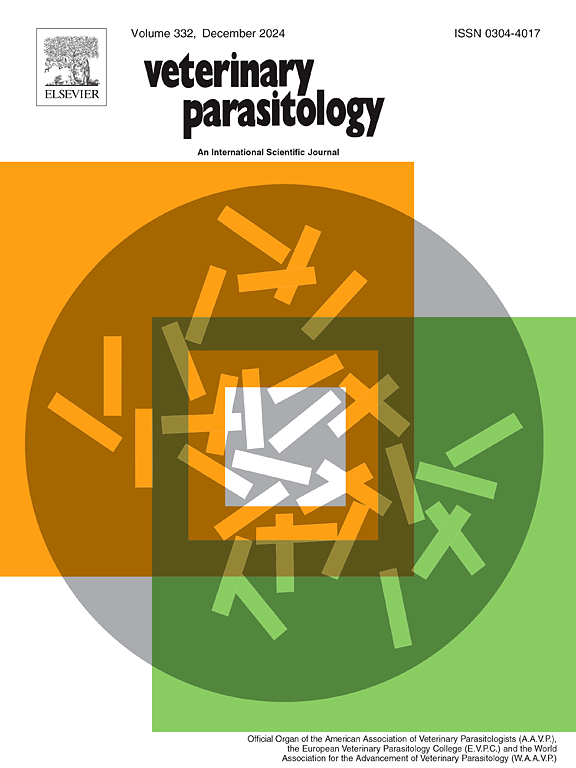使用注射用伊匹诺米星提高亚临床线虫感染山羊的产奶量。
IF 2
2区 农林科学
Q2 PARASITOLOGY
引用次数: 0
摘要
研究人员对自然感染、胃肠道线虫粪卵和肺幼虫数量较低的奶山羊进行了调查,研究了使用含有埃普瑞诺菌素的注射产品对产奶量、牛奶成分和体细胞数(SCC)的影响。这项研究在西班牙南部的一个农场进行,涉及 394 只泌乳山羊。在治疗前,对所有动物的粪便进行分析,根据胃肠道线虫卵计数建立两个同质组(185 只接受治疗和 209 只未接受治疗)。第 0 天,治疗组的每只山羊皮下注射一次 12 毫克的依普菌素(0.6 毫升 Eprecis®,CEVA,西班牙)。对照组山羊则不做任何处理。在治疗后的第 0 天、第 30 天、第 60 天和第 90 天进行粪卵计数和共培养。在第 0、30、60、90 和 120 天采集牛奶样本并进行分析,以确定个体产量和牛奶成分参数,包括脂肪 (F)、蛋白质 (P)、乳糖 (L)、总干浸出物 (TDE) 和 SCC。粪便样本检查结果表明,山羊主要感染了胃肠道强直虫属(Teladorsagia 和 Trichostrongylus)和肺线虫属(Muellerius)。在第 30、60 和 90 天,胃肠道线虫粪卵数的减少率分别为 97.55 %(90 % CI = 95.1 % - 99.9 %)、90.65 %(90 % CI = 83.7 % - 97.6 %)和 87.5 %(90 % CI = 79.5 % - 95.5 %)。粪便中肺部幼虫计数分别为 98.48 % (90 % CI = 96.3 % - 100 %)、96.91 % (90 % CI = 84.2 % - 98.9 %) 和 82.05 % (90 % CI = 66.9 % - 97.2 %)。治疗组的产奶量持续显著高于对照组(p = 0.004)。与未处理的山羊相比,处理组山羊的日产奶量增加了 4%(60 毫升/天)。与未处理的山羊相比,处理组山羊的F和TDE明显下降,但依普菌素对P、L和SCC没有影响。在 120 天的时间里,使用注射用伊普菌素的经济效益估计约为每只山羊 6.46 欧元。总之,注射用伊普菌素对山羊的产奶量有经济上的积极影响,即使是感染胃肠道线虫和肺线虫较少的山羊也是如此。本文章由计算机程序翻译,如有差异,请以英文原文为准。
Increase in dairy production of goats with subclinical nematode infection using injectable eprinomectin
The effect of the treatment with an injectable product containing eprinomectin on milk yield, milk composition, and somatic cell count (SCC) was investigated in naturally infected dairy goats with low gastrointestinal nematode faecal egg and pulmonary larval counts. The study involved 394 lactating goats and was conducted on a farm in southern Spain. Before treatment, faeces from all animals were analysed to establish two homogeneous groups according to the gastrointestinal nematode egg counts (185 treated and 209 untreated). On day 0, each goat in the treatment group received a single subcutaneous injection of 12 mg of eprinomectin (0.6 ml of Eprecis®, CEVA, Spain). The control goats were left untreated. Faecal egg counts and coprocultures were performed on days 0, 30, 60, and 90 post-treatment. Milk samples were taken on days 0, 30, 60, 90, and 120 and analysed to determine individual production and milk composition parameters, including fat (F), protein (P), lactose (L), total dry extract (TDE), and SCC. Examination of faecal samples indicated that the goats were mainly infected with gastrointestinal strongylids of the genera Teladorsagia and Trichostrongylus and Muellerius lungworms. The percentage reduction of gastrointestinal nematode faecal egg counts on days 30, 60, and 90 was 97.55 % (90 % CI = 95.1 % - 99.9 %), 90.65 % (90 % CI = 83.7 % - 97.6 %) and 87.5 % (90 % CI = 79.5 % - 95.5 %), respectively, and that of lung larval counts in faeces was 98.48 % (90 % CI = 96.3 % - 100 %), 96.91 % (90 % CI = 84.2 % - 98.9 %), and 82.05 % (90 % CI = 66.9 % - 97.2 %), respectively. Milk yield was consistently and significantly higher in the treated group than in the control group (p = 0.004). The treated goats showed a 4 % increase in daily milk yield (60 ml/day) compared with the untreated goats. There was a significant decrease in F and TDE in the treated goats compared with the untreated goats, but eprinomectin did not affect P, L, and SCC. The estimated economic benefit of using injectable eprinomectin was around 6.46€ per goat over the 120-day period. In conclusion, treatment with injectable eprinomectin has an economical positive effect on milk yield in goats, even those infected with a low burden of gastrointestinal and pulmonary nematodes.
求助全文
通过发布文献求助,成功后即可免费获取论文全文。
去求助
来源期刊

Veterinary parasitology
农林科学-寄生虫学
CiteScore
5.30
自引率
7.70%
发文量
126
审稿时长
36 days
期刊介绍:
The journal Veterinary Parasitology has an open access mirror journal,Veterinary Parasitology: X, sharing the same aims and scope, editorial team, submission system and rigorous peer review.
This journal is concerned with those aspects of helminthology, protozoology and entomology which are of interest to animal health investigators, veterinary practitioners and others with a special interest in parasitology. Papers of the highest quality dealing with all aspects of disease prevention, pathology, treatment, epidemiology, and control of parasites in all domesticated animals, fall within the scope of the journal. Papers of geographically limited (local) interest which are not of interest to an international audience will not be accepted. Authors who submit papers based on local data will need to indicate why their paper is relevant to a broader readership.
Parasitological studies on laboratory animals fall within the scope of the journal only if they provide a reasonably close model of a disease of domestic animals. Additionally the journal will consider papers relating to wildlife species where they may act as disease reservoirs to domestic animals, or as a zoonotic reservoir. Case studies considered to be unique or of specific interest to the journal, will also be considered on occasions at the Editors'' discretion. Papers dealing exclusively with the taxonomy of parasites do not fall within the scope of the journal.
 求助内容:
求助内容: 应助结果提醒方式:
应助结果提醒方式:


